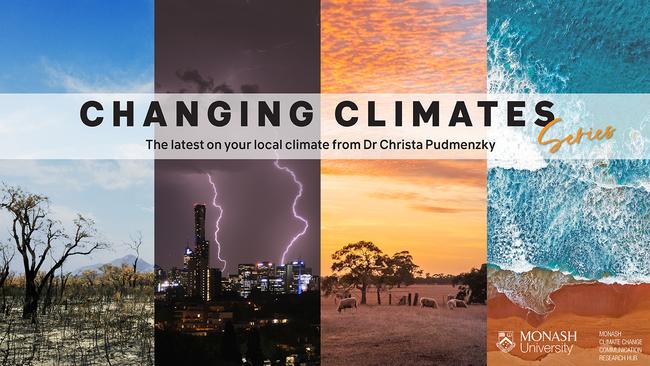Trouble in paradise: the impact of climate change on travel
Host of Logan's Changing Climates series, Dr Christa Pudmenzky explores the impact of climate change on tourism, and strategies for more sustainable travel.

HyperLocal
Don't miss out on the headlines from HyperLocal. Followed categories will be added to My News.
Australia's climate continues to warm at an alarming rate, including here in Logan.
Data from the Bureau of Meteorology shows during September, Queensland's hottest day of the month sits around 33.7C - 1.5C warmer than it was 50 years ago.
While a degree or two might not sound like much, the ripple effect is huge.
From agriculture, to health, the effects of human caused climate change are far reaching.

Tourism in trouble
Tourism, one of our largest industries, is feeling the heat.
Currently, almost 6 million people visit Australia every year, spending an average of $6,207 per trip.
This adds up to a mighty $152 billion for our economy, employing more than 660,000 Australians, and supporting over 300,000 businesses.
Our pristine coastlines attract those wishing to soak up the sun, and our countryside offers everything from hot air ballooning and wine tasting, to up close encounters with cuddly koalas and smiling quokkas at our world famous parks and zoos.
It's no surprise then that many rank Australia near the top of their lists when considering travel destinations.
But as climate change worsens, the safety and feasibility of these activities is under threat.
For instance, rising ocean temperatures are increasing the frequency and severity of coral bleaching events.
The Great Barrier Reef, Ningaloo and Rottnest Island have all experienced several mass bleaching events in the past decade.
The flourishing sea life and vibrant coral, which people from all over the world come to see, will be unable to recover with this higher risk of bleaching if rising global temperatures aren't stabilised.
This alone could cost Australia's economy almost $1 billion and 10,000 jobs per year from reduced tourism, not to mention the deep cultural loss.
However, it's not just our coastal destinations that are struggling.
During summer, both domestic and international tourists flock to the many regional spots on offer, greatly stimulating local economies.
However, with our bushfire season becoming longer and more ferocious, visitors are less likely to take the risk, severely impacting towns that rely heavily on seasonal tourism.
For instance, during the 'Black Summer' bushfires, South Australia's popular tourist destination Kangaroo Island recorded their largest bushfire in history, with over 200,000 hectares - almost half the island - burning.
With much of the wildlife perishing and infrastructure destroyed, tourism all but ceased during efforts to rebuild.
Three years on, after significant restoration, Kangaroo Island is anticipating a booming summer season.
And lastly, while Australian winters also entice holidaymakers, the declining snowfall projected across all alpine regions, shorter seasons and fewer slopes mean even our colder seasons will feel the bite.
Tourism driving emission skyward
Tourism isn't just facing the repercussions of climate change, it's also contributing to them.
Global tourism is responsible for around 8 per cent of global carbon emissions, and Australia's industry accounts for around 5.3 per cent of our national greenhouse gas emissions.
For example, just one return trip between Australia and Europe emits around 4.5 tonnes of carbon - more than the average car will emit in an entire year in Australia.
In fact, some airlines have already considered cutting these long haul flights in order to achieve their 2030 emission reduction targets.
The Australian Airports Association also recently suggested that international flights in and out of the country will get more expensive and occur less in the coming years.
While this may result in a shift to more domestic travel by Aussie holiday-makers, cutting back international flights to Australia ultimately has major implications for the future of our tourism industry and international connectivity.
Managing the travel bug: how to travel more sustainably
The most important thing we can do to protect tourism in Australia, is to lower emissions across all sectors and reach net-zero by 2050.
To help us get there, there are several steps we can take to travel more sustainably.
Travelling locally is a great option.
Australia is full of unique and beautiful places to visit, so we can opt to explore our own backyard and limit travel-related emissions while stimulating our economy.
If you've got your sights set on a European vacay or scuba diving in southeast Asia, then long-haul flights are unavoidable.
However, once you arrive at your destination, you can opt for more climate-conscious options including buses and trains.
When booking flights and accommodation, many sites now offer a 'green filter', which directs you to more eco-friendly and sustainable travel options that produce less emissions.
So whether you're hiking through Kakadu National Park in the Top End, or cliff jumping in Croatia, working to lower emissions will ensure we can continue visiting our favourite destinations for a long time to come.
Want more information on how your climate is changing? Check out the last article in this series.
Dr Christa Pudmenzky is a climate scientist at the University of Southern Queensland.
This column is part of a collaboration between Monash University and News Corp to deliver hyperlocal weather and climate information.


